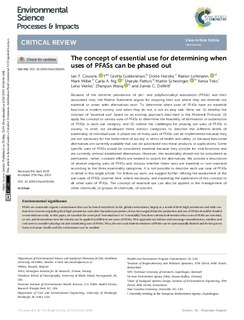| dc.description.abstract | Because of the extreme persistence of per- and polyfluoroalkyl substances (PFASs) and their associated risks, the Madrid Statement argues for stopping their use where they are deemed not essential or when safer alternatives exist. To determine when uses of PFASs have an essential function in modern society, and when they do not, is not an easy task. Here, we: (1) develop the concept of “essential use” based on an existing approach described in the Montreal Protocol, (2) apply the concept to various uses of PFASs to determine the feasibility of elimination or substitution of PFASs in each use category, and (3) outline the challenges for phasing out uses of PFASs in society. In brief, we developed three distinct categories to describe the different levels of essentiality of individual uses. A phase-out of many uses of PFASs can be implemented because they are not necessary for the betterment of society in terms of health and safety, or because functional alternatives are currently available that can be substituted into these products or applications. Some specific uses of PFASs would be considered essential because they provide for vital functions and are currently without established alternatives. However, this essentiality should not be considered as permanent; rather, constant efforts are needed to search for alternatives. We provide a description of several ongoing uses of PFASs and discuss whether these uses are essential or non-essential according to the three essentiality categories. It is not possible to describe each use case of PFASs in detail in this single article. For follow-up work, we suggest further refining the assessment of the use cases of PFASs covered here, where necessary, and expanding the application of this concept to all other uses of PFASs. The concept of essential use can also be applied in the management of other chemicals, or groups of chemicals, of concern. | nb_NO |

